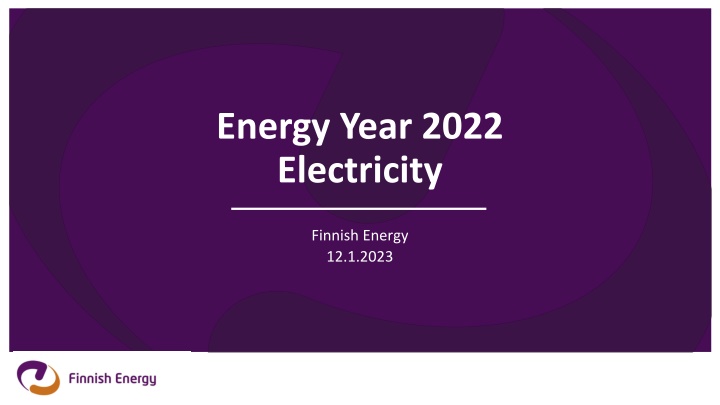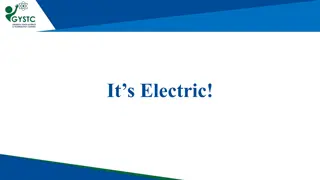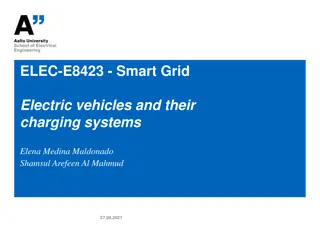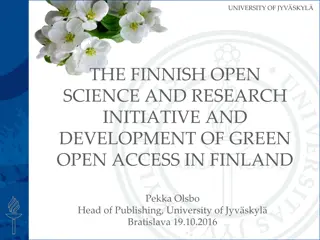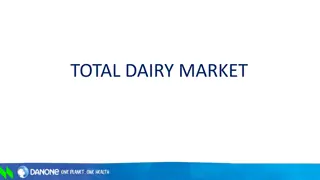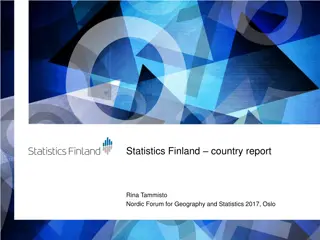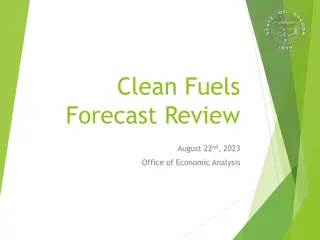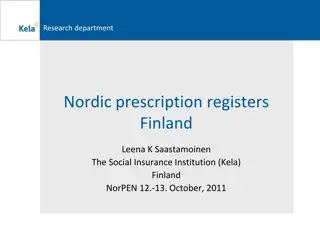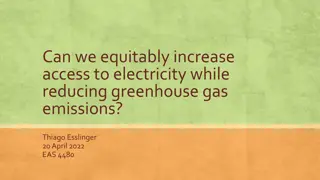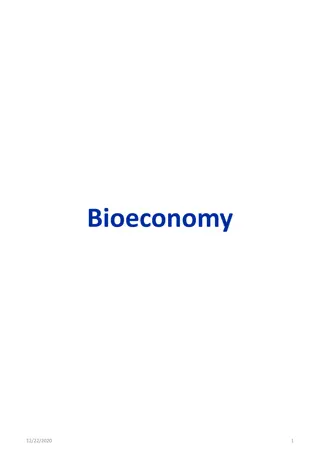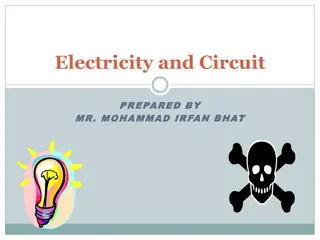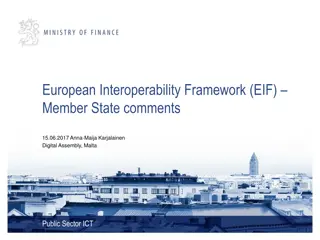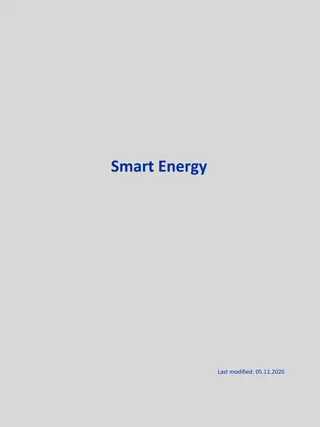Electricity Consumption Trends in Finland 2022
The data provides insights into electricity consumption trends in Finland for the year 2022. It includes information on total electricity consumption, sector-wise distribution of consumption, changes in consumption compared to previous years, and the contribution of different energy sources to the overall electricity generation mix. The visuals showcase variations in consumption across industries, highlighting decreases and fluctuations in different sectors. Additionally, it covers the proportion of CO2-neutral electricity in the energy mix, reflecting efforts towards sustainable energy practices.
Download Presentation

Please find below an Image/Link to download the presentation.
The content on the website is provided AS IS for your information and personal use only. It may not be sold, licensed, or shared on other websites without obtaining consent from the author.If you encounter any issues during the download, it is possible that the publisher has removed the file from their server.
You are allowed to download the files provided on this website for personal or commercial use, subject to the condition that they are used lawfully. All files are the property of their respective owners.
The content on the website is provided AS IS for your information and personal use only. It may not be sold, licensed, or shared on other websites without obtaining consent from the author.
E N D
Presentation Transcript
Energy Year 2022 Electricity Finnish Energy 12.1.2023
Electricity total consumption 82 TWh, 6 % decrease compared to 2021 TWh 100 90 80 70 60 50 40 30 20 10 0 1980 1984 1988 1992 1996 2000 2004 2008 2012 2016 2020 2 12.1.2022
Electricity consumption decreased from the previous year 5,4 TWh change 2021-2022 TWh 8 6 4 2 0 2010 2011 2012 2013 2014 2015 2016 2017 2018 2019 2020 2021 2022 -2 -4 -6 3 12.1.2022
Electricity consumption 2022 Other industry 6% Metal industry 10% Housing and agriculture 30% Chemical industry 8% O Other Consumption total 52% Industry total 44 % 82 TWh Forest industry 20% Services and building 22% Losses 4% 4 12.1.2022
Electricity consumption of industry decreased 6 percent Consumption total 36 TWh TWh 50 40 30 20 10 0 2010 2011 2012 2013 2014 2015 2016 2017 2018 2019 2020 2021 2022 Forest industry Chemical industry Metal industry Other industry 5 12.1.2022
Industrial electricity consumption 2021-2022: most of decrease in forest industry TWh 1 0.5 0 -0.5 -1 -1.5 -2 -2.5 Forest industry Chemical industry Metal industry Other industry 6 12.1.2022
Change of Industrial Electricity Consumption 2021-2022 % 8 6 4 2 0 -2 -4 -6 -8 -10 -12 -14 Forest industry Chemical industry Metal industry Other industry 7 12.1.2022
Electricity by energy source and net imports 2022 Oil 0.2 % Coal 4.7 % Natural gas 1.3 % Hydro power 16.3 % Nuclear power 29.7 % Wind power 14.1 % 82 TWh Solar power 0.5 % Biomass 14.8 % Net imports 15.3 % Peat 2.1 % Waste fuels 1.0 % 8 12.1.2022
The share of CO2-neutral electricity 89 percent Oil 0.2 % Coal 4.7 % 2021 2022 Natural gas 5.3 % Oil 0.2 % Coal 5.6 % Hydro power 22.5 % Natural gas 1.5 % Hydro power 19.3 % Nuclear power 32.7 % 69 TWh Wind power 11.8 % Nuclear power 35.0 % 69 TWh Wind power 16.7 % Solar power 0.4 % Biomass 18.3 % Waste fuels 1.2 % Peat 2.9 % Solar power 0.6 % Waste fuels 1.2 % Biomass 17.4 % Peat 2.5 % Renewable: 54 % (53 % in year 2021) CO2-neutral: 89 % (87 % in year 2021) Domestic: 57 % (57 % in year 2021) 9 12.1.2022
Electricity production in Finland and net imports decreased Solar power 0.5 % Solar power 0.3 % 2022 2021 Wind power 14.1 % Wind power 9.4 % Nuclear power 26.0 % Nuclear power 29.7 % Hydro power 18.0 % Hydro power 16.3 % 82 TWh 87 TWh CHP, district heating 12.2 % CHP, district heating 10.6 % Net imports 15.3 % Net imports 20.4 % CHP, industry 9.0 % CHP, industry 10.4 % Condense etc 4.5 % Condense etc 3.3 % 10 12.1.2022
The end of imports from Russia and Energy crisis changed Energy procurement compared to 2021 Finlands electricity energy source changes 2022 vs 2021 Bio/Peat/Waste Nuclear Power Hydro Power Wind Power Net imports Coal Gas 0 -2 -5 -4 TWh -6 -3 3 -8 -2 2 -10 -1 1 -12 11 12.1.2022
Net imports of electricity decreased almost 30 percent (5.3 TWh) TWh 30 25 Imports 20 Imports from Russia ended in May 204 % Imports from Nordic countries increased 3% (0.4TWh) Exports to Estonia increased 2 % (+0.1 TWh) 15 10 5 0 Exports -5 -10 2010 2011 2012 2013 2014 2015 2016 2017 2018 2019 2020 2021 2022 Nordic countries Estonia Russia 12 12.1.2022
Net imports of electricity 12.5 TWh in year 2022 TWh 25 20 15 10 5 0 2010 2011 2012 2013 2014 2015 2016 2017 2018 2019 2020 2021 2022 13 12.1.2022
Electricity imports changed significantly after May 3000 2500 2000 GWh 1500 1000 500 0 2021 2022 2021 2022 2021 2022 2021 2022 2021 2022 2021 2022 2021 2022 2021 2022 2021 2022 2021 2022 2021 2022 2021 2022 1 2 3 4 5 6 7 8 9 10 11 12 Nordic Countries Russia Estonia 14 12.1.2022
Wind power grows rapidly: Capacity increased 76 percent and production 41 percent MW and GWh 14,000 11,545 12,000 10,000 8,180 7,938 8,000 6,025 5,839 6,000 4,795 4,000 3,068 2,327 5,677 Installed generation capacity at the end of year (MW) Generation (GWh) 2,000 1,107 3,257 774 2,586 2,284 494 481 2,044 2,041 294 277 261 188 1,532 1,004 453 199 0 631 196 2010 259 2012 146 2009 109 2007 142 2008 2011 2013 2014 2015 2016 2017 2018 2019 2020 2021 2022 15 12.1.2022
Hydropower generation TWh 18 16 Average year 14 = hydropower production calculated when flows of built rivers are in average level 12 10 8 6 4 2 0 2010 2011 2012 2013 2014 2015 2016 2017 2018 2019 2020 2021 2022 16 12.1.2022
Generation and capacity of CHP in district heating MW and GWh 18,000 16,909 15,257 16,000 14,591 14,804 13,602 14,000 12,785 12,267 13,897 12,119 11,988 11,983 11,607 12,000 10,647 10,000 8,625 9,475 8,000 6,000 4,000 2,000 3,550 3,490 3,490 3,430 3,350 3,350 3,250 3,150 3,150 3,097 3,097 3,061 3,051 3,051 3,021 0 2008 2009 2010 2011 2012 2013 2014 2015 2016 2017 2018 2019 2020 2021 2022 Electricity generation capacity in peak load period (MW)* Generation (GWh) *Peak load capacity is not included from year 2017 *Source: Statistics Finland, Energy 2022 table service, table 3.5 17 12.1.2022
Generation and capacity of CHP in industry MW and GWh 14,000 11,885 12,000 11,189 10,739 9,724 9,576 9,554 10,000 9,277 9,066 9,109 8,879 8,710 8,614 9,536 9,389 8,000 7,331 6,000 4,000 2,000 2,450 2,450 2,370 2,365 2,330 2,330 2,300 2,250 2,250 2,250 2,250 2,250 2,150 2,000 1,990 0 2008 2009 2010 2011 2012 2013 2014 2015 2016 2017 2018 2019 2020 2021 2022 Electricity generation capacity in peak load period (MW)* Generation (GWh) *Source: StatisticsFinland, Energy 2022 table service, table 3.5 18 12.1.2022
Generation and capacity of condensing power MW and GWh 16,000 14,179 14,000 12,000 9,822 10,000 8,779 8,883 8,000 8,963 6,379 6,000 4,748 4,319 4,062 3,706 5,177 4,000 3,284 3,142 2,848 2,311 2,000 2,650 2,650 2,200 2,200 2,045 2,045 1,650 1,600 540 960 502 502 502 370 540 0 2008 2009 2010 2011 2012 2013 2014 2015 2016 2017 2018 2019 2020 2021 2022 Electricity generation capacity in peak load period (MW)* Generation (GWh) *Peak load capacity is not included from year 2017 *Source: Statistics Finland, Energy 2022 table service, table 3.5 19 12.1.2022
Electricity Generation with Coal total of moving 12 months GWh 18,000 16,000 14,000 12,000 10,000 8,000 6,000 4,000 2,000 0 12/06 12/07 12/08 12/09 12/10 12/11 12/12 12/13 12/14 12/15 12/16 12/17 12/18 12/19 12/21 12/22 12/20 20 12.1.2022
CO2-emissions of power generation-downward trend continues 1000 t CO2 g g CO2/ kWh(e) 30,000 250 CO2-emissions of power generation: 4.4 Mt in year 2022 4.7 Mt in year 2021 4.3 Mt in year 2020 6.9 Mt in year 2015 19 Mt in year 2010 227 EU-27, v. 2020: 229 g CO2/ kWh Source: EEA 25,000 200 182 160 20,000 150 133 124 15,000 111 107 97 95 100 83 10,000 68 64 64 2022 vs. 2021 -6 % 50 5,000 Emissions -39 % in last 5 years 0 0 Emissions -77 % vs 2010 2010 2011 2012 2013 2014 2015 2016 2017 2018 2019 2020 2021 2022 Condense etc CHP Specific carbon dioxide emissions 21 12.1.2023
Peak loads of electricity maximum electricity MW MW 16,000 14,000 12,000 10,000 8,000 Peak of year 2022 14 058 MW (11.1.2022) 6,000 4,000 2,000 0 1980 1984 1988 1992 1996 2000 2004 2008 2012 2016 2020 22 12.1.2022
Electricity supply hourly in year 2022 peak load day 11.1. MW 0 2,000 4,000 6,000 8,000 10,000 12,000 14,000 16,000 1 12638 2 12357 3 12189 4 12186 5 12293 6 12627 7 13505 8 13863 9 14058 10 13893 11 13788 12 13798 13 13650 14 13484 15 13325 16 13292 17 13456 18 13434 19 13312 20 13224 21 12855 22 12282 23 12270 24 11932 2799 2800 2798 2800 2801 2801 2801 2800 2799 2800 2800 2800 2799 2800 2800 2800 2800 2800 2801 2801 2802 2801 2801 2800 1532 1558 1465 1376 1394 1519 1816 1984 2223 2251 2286 2248 2045 2103 2023 1940 2044 2198 2206 2281 2218 1926 1720 1581 1414 1725 1953 2131 2235 2280 3180 669 3044 2520 2222 2152 2158 3139 3135 3102 3074 614 617 623 632 3062 631 2333 2306 2362 3059 3101 620 2904 615 3001 2407 2394 2403 2446 2532 2549 2542 2574 2461 2430 2352 2411 2455 2458 2434 2382 3338 3438 3213 3141 3074 3051 2959 2856 2847 2854 2825 2785 2688 2563 2541 2510 661 693 632 656 674 682 684 670 682 690 710 716 748 716 726 704 2629 2317 2454 2507 2526 2299 2317 2452 2621 2462 2417 2229 1944 1818 2047 1956 Nuclear power Hydro power Wind and solar power CHP Condence etc Net imports 23 12.1.2022
Variation of Electricity Production and Imports in 2022 average week power MW 14,000 12,000 10,000 8,000 6,000 4,000 2,000 0 1 3 5 7 9 11 13 15 17 19 21 23 25 27 29 31 33 35 37 39 41 43 45 47 49 51 Nuclear power CHP, industry CHP, district heating Condence etc Hydro power Wind power Solar power Net imports 24 12.1.2022
Electricity spot markets are in an unprecented rise and change
In 2022, wholesale electricity price in Finland was considerably higher than in the previous years Annual electricity spot prices in Finland 180 160 140 120 100 /MWh 80 60 40 20 0 2013 2014 2015 2016 2017 2018 2019 2020 2021 2022 Source: Nord Pool 26 Tekij tai esityksen nimi 15.2.2025
Price of electricity in Finland was the second-lowest in the entire EU great price differences compared to Central Europe Electricity spot prices on average 2022 300 250 200 /Mwh 150 100 50 0 Finland Northern Sweden Stockholm Oslo Copenhagen Germany France Estonia Source: Nord Pool 27 Tekij tai esityksen nimi 15.2.2025
Electricity prices rose in Europe mainly due to the reduced amounts of Russian natural gas and other energy in the market Electricity spot prices 2020-2022 600 Society starts to open up after COVID-19 restrictions and the demand for electricity increases. Exceptionally low prices come to an end. Gas and electricity imports from Russia are reduced considerably during spring and summer. Cold December raised gas and electricity prices. Russia attacks Ukraine. 500 400 Russia starts to limit gas imports to Europe. /MWh 300 200 100 0 jan 2020 April-20 July-20 October-20 January-21 April-21 July-21 October-21 January-22 April-22 July-22 October-22 Finland Stockholm France Germany L hde: Nord Pool 28 Tekij tai esityksen nimi 15.2.2025
Price of electricity has followed the price of natural gas, which has multiplied in Central Europe The price of natural gas has increased 20 30-fold from the low prices in 2020. About 20% of electricity in the EU is produced with natural gas. In many countries this share is much higher. For the time being, gas is a necessary fuel with respect to sufficient electricity supplies. The wholesale price of electricity in Finland partly follows the Central European prices, but not in full. When there is plenty of Nordic production on offer, our price level falls considerably lower. Electricity spot price and the price of monthly gas products in Finland and Germany 500 300 450 250 400 350 200 /MWh (Electricity) /MWh (Gas) 300 250 150 200 100 150 100 50 50 0 0 Finland Germany Gas (TTF) Sources: Nord Pool & Trading Economics 29 Tekij tai esityksen nimi 15.2.2025
In addition to gas, the hot and dry summer and challenges in nuclear power plants also contributed to the crisis The rise in electricity prices is also partly explained by the reduced supply of nuclear and hydro power. There are a number of faults and maintenance issues especially in French nuclear power plants, due to which production has plummeted. The dry year has reduced the supply of hydro power. Reduced use of electricity and increased production of wind and solar power have not been enough to meet the shortfall in nuclear and hydro power. It has been necessary to utilise more coal power in electricity production, and even the hugely expensive natural gas has been slightly more in demand than in the previous year. Change in electricity production by production form 2022 vs. 2021 January-November Other Renewables Nuclear Power Other Fossiles Hydro Power Wind Power Solar Power Bio Energy Coal Gas 0 -20 -40 -112 -60 -80 38 TWh -100 -120 37 -140 -65 34 -160 -5 -2 -1 11 -180 -200 Sources: Bruegel & Ember 30 Tekij tai esityksen nimi 15.2.2025
Electricity spot prices by country 2022 High prices are not only a Finnish phenomenon Prices in Norway, Denmark, Sweden and Italy are from the price areas of the capital cities Prices have been very high throughout Europe. The electricity wholesale market is common, i.e. pricing takes place according to supply and demand in the entire region. Electricity is transmitted in the grid towards a higher price. Electricity transmission links are not enough to ensure the same price in all areas. The prices have been highest in countries that have a lot of production based on fossil fuels or not enough own production capacity. Sweden has had the lowest prices, and Finland has imported a lot of electricity from Sweden. Correspondingly, electricity has been exported from Finland to Estonia. 31 Tekij tai esityksen nimi 15.2.2025 Source: Nord Pool
Electricity price fluctuations have been high this year highest prices seen in August and in early December Weekly electricity spot prices in Finland in 2022 450 In January April, Finland had the lowest wholesale electricity prices in Europe together with Sweden. The prices increased when electricity imports from Russia stopped and gas became more expensive. In late November and early December, the weather was widely cold with low winds in Central and North-West Europe. 400 350 300 250 /MWh 200 150 100 50 0 1 3 5 7 9 11 13 15 17 19 21 23 25 27 29 31 33 35 37 39 41 43 45 47 49 51 L hde: Nord Pool 32 Tekij tai esityksen nimi 15.2.2025
Price difference between Finland and Sweden grew further The reason for the price difference between Finland and Sweden is the insufficient transmission capacity to transmit lower- priced electricity to the neighbouring country. In the past few years, Finland has usually imported a substantial volume of electricity from Sweden. The challenge for Finland is that our production capacity is not sufficiently high. In sub-zero temperatures during high demand or low winds, the prices can rise extremely high even if electricity prices in Sweden were lower. Increasing own power production and growing the transmission capacity will reduce the price difference. Annual electricity spot prices in Finland and the Stockholm region 180 160 140 120 100 /MWh 80 60 40 20 0 2002 2003 2004 2005 2006 2007 2008 2009 2010 2011 2012 2013 2014 2015 2016 2017 2018 2019 2020 2021 2022 Finland Stockholm (2002-2011 Sweden) L hde: Nord Pool 33 Tekij tai esityksen nimi 15.2.2025
Outlook for electricity prices is promising especially in terms of Finland and Sweden Future electricity deliveries are traded on the electricity derivatives market. The price outlook is declining in Finland and Sweden. In Germany, high prices seem to be continuing. The situation in Finland and Sweden is explained by the fact that we have a constant plentiful supply of new electricity production. Moreover, we are not dependent on gas in electricity production which would keep prices at a constantly high level. Actual electricity spot prices & futures 500 450 400 350 300 /MWh 250 200 150 100 50 0 Finland Stockholm Germany Finland Fut. Stockholm Fut. Germany Fut. Futuure prices from 29.12.2022 Sources: Nord Pool, Nasdaq OMX & EEX 34 Tekij tai esityksen nimi 15.2.2025
The low carbonization of traffic is progressing
Petrol and diesel car sales in Finland (new passenger cars, plug-in hybrid cars not included) No. 120,000 100,000 80,000 60,000 40,000 20,000 0 2016 2017 2018 2019 2020 2021 2022 Diesel Petrol Source: Traficom 36 12.1.2022
Alternative power sources for the first registration of passenger cars % 45 40 35 30 25 20 15 10 5 0 2016 2017 2018 2019 2020 2021 2022 Gas cars Plug-in hybrid cars Electric cars Source: Traficom 37 12.1.2022
Alternative power sources in passenger cars in traffic by end of the year No. 120,000 104,039 100,000 76,990 80,000 60,000 45,621 44,889 40,000 22,921 24,704 14,395 15,622 20,000 13,095 12,366 9,388 9,697 2,437 5,719 5,607 4,661 3,161 1,508 1,825 2,404 1,449 614 1,017 844 0 2015 2016 2017 2018 2019 2020 2021 2022 Electric vehicles Gas vehicles Plug-in hybrid cars Source: Traficom 38 12.1.2022
